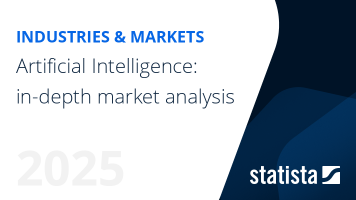Facial Recognition - Malaysia
Malaysia- The market size in the Facial Recognition market is projected to reach US$47.74m in 2025.
- The market size is expected to show an annual growth rate (CAGR 2025-2031) of 36.26%, resulting in a market volume of US$305.59m by 2031.
- In global comparison, the largest market size will be United States (US$1.43bn in 2025).
Definition:
Facial recognition, as part of computer vision, is a technology that involves the identification and verification of individuals by analyzing and comparing unique facial features. It uses algorithms to capture, analyze, and match facial patterns from images or video frames. By extracting key facial landmarks and characteristics, such as the distance between the eyes, the shape of the nose, and the contours of the face, facial recognition systems can accurately recognize and authenticate individuals. The applications for this technology are diverse and include the areas of access control, surveillance, user authentication, and personalized experiences in digital platforms.
Additional Information:
The market comprises two key performance indicators: market sizes and market sizes by industry. Market sizes are generated by the funding amount of Computer Vision companies. Key players of the market include companies such as Nvidia, Intel, and IBM.
For more information on the data displayed, use the info button right next to the boxes.
- Technologies that use machine learning algorithms to analyze and identify human faces in digital images and/or videos, such as face detection and recognition software
- Products and services that use facial recognition technology, such as security systems, mobile devices, and augmented reality apps.
- Technologies that do not rely on facial recognition, such as voice recognition and image recognition technologies that do not specifically target faces
- Products and services that do not use facial recognition technology, such as physical goods and traditional customer service support.
Market Size
Notes: Data was converted from local currencies using average exchange rates of the respective year.
Most recent update: Oct 2025
Source: Statista Market Insights
Notes: Data was converted from local currencies using average exchange rates of the respective year.
Most recent update: Oct 2025
Source: Statista Market Insights
Analyst Opinion
Three trends in facial recognition are shaping the market. One is the enhancement of security and related processes in the retail, banking, and healthcare industries, among others. Another is the improvement of facial recognition algorithms to increase accuracy, especially in challenging conditions such as low light and occluded faces. A third is the development of transparent and accountable practices to ensure user consent and data protection (in response to privacy concerns and ethical considerations).
The facial recognition market is expected to continue growing in the coming years, driven by several factors. One of the key growth factors is the increasing demand for security and surveillance systems, particularly in public places such as airports, shopping malls, and government buildings. Another is the increasing adoption of facial recognition in various industries such as healthcare, banking, and retail is expected to contribute to market growth. A third growth factor is the advancement in facial recognition technology, such as 3D facial recognition, which provides more accurate and reliable results.
The Facial Recognition market is expected to continue growing at a significant pace until 2030. The market is projected to grow at a compound annual growth rate (CAGR) of 11.1% during the forecast period.
Global Comparison
Notes: Data was converted from local currencies using average exchange rates of the respective year.
Most recent update: Oct 2025
Source: Statista Market Insights
Methodology
Data coverage: The data encompasses B2B, B2G, and B2C enterprises. Figures are based on the funding values from different industries for the market.
Modeling approach / Market size:Market sizes are determined through a top-down approach with a bottom-up validation, building on a specific rationale for each market. As a basis for evaluating markets, we use annual financial reports, funding data, and third-party data. In addition, we use relevant key market indicators and data from country-specific associations such as GDP, number of internet users, number of secure internet servers, and internet penetration. This data helps us estimate the market size for each country individually.
Forecasts:In our forecasts, we apply diverse forecasting techniques. The selection of forecasting techniques is based on the behavior of the relevant market. For example, the S-curve function and exponential trend smoothing are well suited to forecast digital products and services due to the non-linear growth of technology adoption. The main drivers are the level of digitalization, the number of secure internet servers, and the revenue of the Public Cloud market.
Additional Notes: The data is modeled using current exchange rates. The impact of the COVID-19 pandemic and the Russian-Ukraine war are considered at a country-specific level. The market is updated twice a year. In some cases, the market is updated on an ad-hoc basis (e.g., when new, relevant data has been released or significant changes within the market have an impact on the projected development). Data from the Statista Consumer Insights Global survey is weighted for representativeness.
Key Market Indicators
Notes: Based on data from IMF, World Bank, UN and Eurostat
Most recent update: Jan 2025
Source: Statista Market Insights
Explore more high-quality data on related topic
Artificial intelligence (AI) worldwide - statistics & facts
Explore more high-quality data on related topic
Artificial intelligence (AI) in the U.S. - statistics & facts
Contact


+44 (0)20 8189 7000
Mon - Fri, 9:30am - 5pm (GMT)

Mon - Fri, 10:00am - 6:00pm (JST)

+1 212 419-5774
Mon - Fri, 9am - 6pm (EST)

+65 6995 6959
Mon - Fri, 9am - 5pm (SGT)



